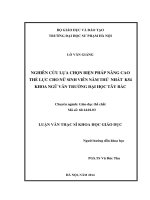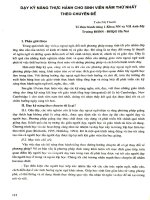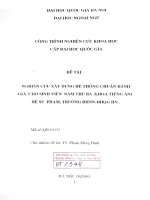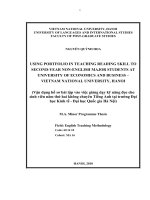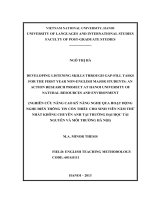Nghiên cứu nâng cao kỹ năng nghe qua hoạt động nghe điền thông tin còn thiếu cho sinh viên năm thứ nhất không chuyên Anh tại trường Đại học Tài nguyên và Môi tr
Bạn đang xem bản rút gọn của tài liệu. Xem và tải ngay bản đầy đủ của tài liệu tại đây (1.33 MB, 89 trang )
VIETNAM NATIONAL UNIVERSITY, HANOI
UNIVERSITY OF LANGUAGES AND INTERNATIONAL STUDIES
FACULTY OF POST-GRADUATE STUDIES
-------------------
NGÔ THỊ HÀ
DEVELOPING LISTENING SKILLS THROUGH GAP-FILL TASKS
FOR THE FIRST YEAR NON-ENGLISH MAJOR STUDENTS: AN
ACTION RESEARCH PROJECT AT HANOI UNIVERSITY OF
NATURAL RESOURCES AND ENVIRONMENT
(NGHIÊN CỨU NÂNG CAO KỸ NĂNG NGHE QUA HOẠT ĐỘNG
NGHE ĐIỀN THƠNG TIN CỊN THIẾU CHO SINH VIÊN NĂM THỨ
NHẤT KHÔNG CHUYÊN ANH TẠI TRƯỜNG ĐẠI HỌC TÀI
NGUYÊN VÀ MÔI TRƯỜNG HÀ NỘI)
M.A. MINOR THESIS
FIELD: ENGLISH TEACHING METHODOLOGY
CODE: 6014.0111
HANOI – 2013
VIETNAM NATIONAL UNIVERSITY, HANOI
UNIVERSITY OF LANGUAGES AND INTERNATIONAL STUDIES
FACULTY OF POST-GRADUATE STUDIES
-------------------
NGÔ THỊ HÀ
DEVELOPING LISTENING SKILLS THROUGH GAP-FILL TASKS
FOR THE FIRST YEAR NON-ENGLISH MAJOR STUDENTS: AN
ACTION RESEARCH PROJECT AT HANOI UNIVERSITY OF
NATURAL RESOURCES AND ENVIRONMENT
(NGHIÊN CỨU NÂNG CAO KỸ NĂNG NGHE QUA HOẠT ĐỘNG
NGHE ĐIỀN THƠNG TIN CỊN THIẾU CHO SINH VIÊN NĂM THỨ
NHẤT KHÔNG CHUYÊN ANH TẠI TRƯỜNG ĐẠI HỌC TÀI
NGUYÊN VÀ MÔI TRƯỜNG HÀ NỘI)
M.A. MINOR THESIS
FIELD: ENGLISH TEACHING METHODOLOGY
CODE: 6014.0111
SUPERVISOR: Prof. Dr. HOÀNG VĂN VÂN
HANOI - 2013
DECLARATION
I hereby declare that this thesis is the result of my own research and that the
substance of the thesis has not, wholly or in part, been submitted for a degree to any
other university or institution.
Hanoi, December, 2013
Ngô Thị Hà
i
ACKNOWLEDGEMENTS
This thesis has been accomplished with the help and encouragement of many
people.
I would like to express my deep gratitude to all of them.
First and for most, I would like to express my sincere gratitude to my supervisor,
Prof. Dr. Hoàng Văn Vân. His profound knowledge in both linguistics and language
teaching methodology has been of great benefit to me. Without his precious
guidance, insightful comments and suggestions, and invaluable encouragement, my
thesis might not have been finished.
I would also like to send my deep thanks to the staff of the Faculty of Post-graduate
Studies for their help and to all the lecturers for their interesting lectures and
supports, which are really useful for this research.
Besides, my special thanks should also be expressed to my colleagues and students
at HUNRE. Their cooperation brought great contribution to the success of my
study.
Last but not least, my sincere thanks were sent to my family and my friends for their
encouragement and moral supports. Without them beside me, I might not have
completed the research.
ii
ABSTRACT
This research was conducted with the purpose to investigate the effect of using gapfill tasks on developing students‟ listening skills. The study was carried out in form
of an action research. The subjects of the study were 45 first-year non-English
major students from class DH2K1 of Hanoi University of Natural Resources and
Environment (HUNRE). Data were collected through talks with students and
colleagues; document analysis (course books and results of the first semester);
teaching and learning diaries, and pre and post tests. The research was conducted
during nine weeks.
Initial investigation of the study showed that almost students at HUNRE found
listening challenging and many difficulties perceived by students were revealed.
Among those, the biggest problems were of the unsuitability between the listening
tasks and students‟ level. To better the situation, an action plan was made with
focus on using gap-fill tasks to help students develop their listening skills.
The intervention was fairly successful in improving students‟ listening skills. Their
listening ability was upgraded and they also felt more interested in listening lessons.
Basing on the findings of the research, some conclusions were drawn out.
Recommendations, limitations and suggestions were also discussed.
It is hoped that the present study will be helpful for English teachers who share the
same wish to help students solve their problems in learning listening skills at
HUNRE.
Ngô Thị Hà
iii
LIST OF ABBREVIATIONS
HUNRE: Hanoi University of Natural Resources and Environment
L2: second language
TESOL: Teachers of English to Speakers of Other Languages
GE: General English
ESP: English for Specific Purpose
NCE: New Cutting Edge
MA: Master
PhD: Doctor of Philosophy
iv
LIST OF CHARTS AND TABLE
CHARTS
Chart 1: Students‟ results of the first semester
Chart 2: Results of the pre-test
Chart 3: Results of the three meetings
Chart 4: Students‟ comments about vocabulary of the recordings
Chart 5: Students‟ comments about the grammar‟s difficulty of the recordings
Chart 6: Students‟ comments about the length of the recordings
Chart 7: Students‟ comments about the speed of the recordings
Chart 8: Students‟ comments about the level of tasks‟ difficulty
Chart 9: Students‟ comments about their accomplishment of the tasks
Chart 10: Results of the post test
Chart 11: Students‟ improvement through tests.
TABLES
Table 1: List of topics conveyed in each module of the course books
Table 2: List of listening tasks in each module of the course books.
v
TABLE OF CONTENT
Page
Declaration ................................................................................................................... i
Acknowledgements .....................................................................................................ii
Abstract ..................................................................................................................... iii
List of abbreviations ................................................................................................... iv
List of Charts and Tables ............................................................................................ v
Table of Content ......................................................................................................... vi
PART I: INTRODUCTION ........................................................................................ 1
1.Rationale of the study............................................................................................... 2
2.Aims of the study ..................................................................................................... 2
3.Research questions ................................................................................................... 2
4.Scope of the study .................................................................................................... 2
5.Methodology ........................................................................................................... 2
6.Design of the study................................................................................................... 3
PART II: DEVELOPMENT ...................................................................................... 5
CHAPTER I: LITERARUTE REVIEW .................................................................... 5
1.1. Listening skills ..................................................................................................... 5
1.1.1. Definitions of listening and listening comprehension ..................................... 5
1.1.1.1. Listening ........................................................................................................ 5
1.1.1.2. Listening comprehension .............................................................................. 5
1.1.2. Listening skills in learning a foreign language ................................................ 7
1.1.3. Difficulties in learning listening skills ............................................................. 8
1.1.4. Listening material ............................................................................................. 9
1.1.5. Listening tasks ................................................................................................ 11
1.1.5.1. Definition of task ......................................................................................... 11
1.1.5.2. Types of listening tasks ............................................................................... 11
1.2. Gap-fill tasks ..................................................................................................... 13
vi
1.2.1. Gap-fills tasks in learning listening skills ...................................................... 13
1.2.2. Types of gap-fill exercises or tests .................................................................. 14
1.3. Previous studies ................................................................................................. 17
CHAPTER II: THE METHODOLOGY .................................................................. 18
2.1. Context of the study ........................................................................................... 18
2.1.1. An overview of teaching and learning English at HUNRE ............................ 18
2.1.2. Facilities and learning condition ..................................................................... 19
2.2. Course books analysis ........................................................................................ 20
2.3. The Participants .................................................................................................. 20
2.4. Data collecting instruments. ............................................................................... 21
2.4.1. Talks with colleagues and students ................................................................. 21
2.4.2. Pre-test............................................................................................................. 21
2.4.3. Learning diaries ............................................................................................... 21
2.4.4. Teaching diaries .............................................................................................. 22
2.4.5. Post-Test .......................................................................................................... 22
2.5. The research procedure ...................................................................................... 22
2.5.1. Phase 1: Diagnosing ........................................................................................ 22
2.5.2. Phase 2: Action Planning ................................................................................ 23
2.5.3. Phase 3: Taking Action ................................................................................... 24
2.5.4. Phase 4: Evaluating ......................................................................................... 24
2.5.5. Phase 5: Specifying Learning.......................................................................... 25
2.6. Summary ............................................................................................................ 25
CHAPTER III: DATA ANALYSIS AND FINDINGS ............................................ 26
3.1. Diagnosing data ................................................................................................. 26
3.1.1. Analysis of the text book................................................................................. 26
3.1.2. Analysis of talks with colleagues .................................................................... 28
3.1.3. Analysis of talks with students ........................................................................ 29
3.1.4. Analysis of the students‟ results of the first semester ..................................... 30
3.1.5. Analysis of the pre-test.................................................................................... 30
vii
3.1.6. Concluding remarks ....................................................................................... 31
3.2. Action planning .................................................................................................. 31
3.2.1. Meeting 1 ........................................................................................................ 32
3.2.2. Meeting 2 ........................................................................................................ 33
3.2.3. Meeting 3 ........................................................................................................ 33
3.3. Taking action phase............................................................................................ 34
3.3.1. Results of the exercises in four meetings ....................................................... 34
3.3.2. Results of learning diaries ............................................................................... 35
3.3.3. Results of teaching diaries ............................................................................. 39
3.3.4. Results of post-test ......................................................................................... 40
3.4. Action research evaluation ................................................................................ 40
3.4.1. Students‟ improvement through tests .............................................................. 40
3.4.2. Students‟ involvement in listening tasks ........................................................ 41
3.5. Major findings and discussions ......................................................................... 41
3.5.1. Effect of gap-fill tasks on developing students‟ listening skills from
perspective of the students ....................................................................................... 42
3.5.2. Effect of gap-fill tasks on developing students‟ listening skills from the
perspective of the teacher .......................................................................................... 42
PART III: CONCLUSION ........................................................................................ 43
3.1. Recapitulation ................................................................................................... 43
3.2. Conclusion .......................................................................................................... 44
3.3. Recommendations ............................................................................................. 44
3.4. Limitation of the study ...................................................................................... 45
3.5. Suggestions for further study ............................................................................ 46
REFERENCES .......................................................................................................... 47
APPENDICES ............................................................................................................ I
viii
PART I
INTRODUCTION
1. Rationale of the study
The role of English as “global language” has now been asserted with many
eloquent testimonies of its usefulness and contributions in many fields of life such
as science, technology, culture, education, economy, entertainment and so on.
English has helped people closer in „global village‟ (Nguyen, T. N., 2008) and
helped them broaden their knowledge as well. With its wide use as the dominant
language in media, books, etc, English has brought people many chances to get to
know about other countries and their cultures, literature works, traditions, etc., thus,
broaden their knowledge with the help of the common and popular language.
English is used as the most common language in external communication of
many fields. Since “Đoi moi” with “opened” policy, Vietnam has been “closer” to
the dynamic outside world. Vietnamese people now can easily access information,
entertainments, books, science, and high technology which are usually in English.
Businessmen, tourists, scientists, etc. come to Vietnam bringing with them many
chances to help develop the country in many aspects. Most of them often use
English in communication that makes the use of English in Vietnam more and more
widely and important.
In the Educational System of Vietnam, English has now been a compulsory
subject in curriculums in schools and universities. English is considered not only an
interest or a favourite subject but also practical and great demand for students for
their higher study as well as for their success in the future. Thus, “its study is
considered as an academic pursuit” (Nguyen, T. N., 2008).
In learning English for communicative purposes, learning skills receives
great interests. Although each of the four skills – reading, listening, writing,
speaking, has their own characteristics and they are challenging in their own way,
listening is considered the most challenging skill. The factors that affect the
students‟ listening ability are various, they may come from the students themselves
(their background knowledge, motivation, interest…), from the learning context,
from the learning material, or from teaching syllabus.
1
In attempt to improving students‟ listening skills, I have decided to carry out
a study namely “Developing Listening Skills through Gap-fill Tasks for the First
Year Non-English Major Students: an Action Research Project at Hanoi
University of Natural Resources and Environment”
2. Aims of the study
The main purpose of this research is to study the effects of using gap-fill
tasks on improving the students‟ listening skills at Hanoi University of Natural
Resources and Environment (HUNRE). The specific objectives of the study are:
- To figure out difficulties perceived by students in learning listening skills.
- To find out effective ways to help improve students‟ listening skills.
- To investigate whether doing gap-fill listening tasks can help students improve
their listening skills from students and teacher‟s perspectives.
3. Research questions
In order to obtain the objectives of the study, the following research questions were
formulated:
1) What are the difficulties experienced by the first – year students at HUNRE
in learning listening skills?
2) What should be done to improve the students’ listening skills?
3) To what extent do gap-fill tasks help the first-year students at HUNRE
improve their listening skills, from both students’ and teacher’s perspectives?
4. Scope of the study
With the limit of a minor thesis and due to the limited knowledge and time, I
could just carry out the investigation on a small scale. This action research was
conducted for only nine weeks with three listening lessons and in the context of 45
first-year students at HUNRE in the second semester of the academic year 20122013. In additions, as aforementioned, this study focuses on using gap-fill exercises
to teach listening skills to the above students. Hence, the results of this study is
limited to the above teaching context and participants.
5. Methodology
2
To realize the objectives of the study, both qualitative and quantitative methods
are used. The data for the study were collected through the following instruments:
-
Talks with colleagues and students: were conducted at the very beginning of
the study to identify students‟ problems in learning listening skills.
-
Document analysis 1: the analysis focuses on listening tasks in the course
books to see whether they are suitable with students level and interests or not.
Then some adjustments could be made to match students‟ level and interests.
-
Document Analysis 2: The analysis of students‟ results of the first semester was
conducted to have deeper understanding of students‟ right competence in
English.
-
Pre-test was designed to find out the students‟ listening skills through gap-fill
tasks, before taking the action.
-
Learning diaries were done by students (with clear instruction of the
researcher) to record their comments on the tasks and exercises as well as the
effectiveness of the lesson, the difficulties perceived by the students during the
lesson, and their general comments on the learning listening skills through gapfill tasks.
-
Teaching diaries were written after each lesson to record the students‟ reaction
or performance in learning listening skills through gap-fill tasks. The diaries also
record the effectiveness of the lesson, the difficulties occurred during the lesson
in the perspective of the teacher.
-
Post-test was designed to find out the students‟ listening skills through gap-fill
tasks, after taking the action.
6. Design of the study
The study consists of three parts as follows:
Part I: The Introduction provides the basic information such as rationale of
the study, aims of the study, research questions, scope of the study, methods of the
study and the design of the study.
Part II: The Development consists of three chapters. Chapter I is the
literature review in which theoretical background relevant to the purpose of the
3
study is discussed. In the second chapter, Chapter II, the methodology of the study
is explained with detailed description of how the study is conducted. The last
chapter is to report the data analysis as well as the results of the study.
Part III: The Conclusion summarizes what has been studied. Then some
recommendations are proposed, some limitations of the study are pointed, and some
suggestions for further research are offered.
4
PART II
DEVELOPMENT
CHAPTER I: LITERATURE REVIEW
1.1.
Listening skills
1.1.1. Definitions of listening and listening comprehension
1.1.1.1. Listening
The definitions of listening vary from author to author and in fact it is not
easy to describe as well as to have a thorough view of it. Accordingly, Field (1989)
states that “listening is an invisible mental process, making it difficult to describe.
Learners must discriminate between sounds, understand vocabulary and grammar
structures, interpret stress and intonation, retain and interpret this within the
immediate as well as the large socio-culture context of utterance.” (Field, 1989).
Brown (1994) also shared the above view when arguing that listening is a skill in
which to identify and understand what is being said, listeners must comprehend “a
speaker‟s accent or pronunciation, his grammar and his vocabulary”. To make it
easier to understand, Rost (2002) gave a clear description in which he defined
“listening, in its broad sense, is a process of receiving what the speaker actually
says (receptive orientation); constructing and representing meaning (constructive
orientation); and creating meaning through involvement, imagination and empathy
(transformative orientation)
It can be seen from the above views that listening is not a simple activity of hearing
things but it is a complex mental process requiring a listener to have certain
competence to understand an aural message.
1.1.1.2. Listening comprehension
As with listening, listening comprehension is defined differently by different
authors, but we can see a common view that listening comprehension is thought not
to be a single activity but a complicated process. According to Boyle (1983),
“Listening comprehension is defined as the process of understanding speech in a
second or foreign language. When comprehending something, we can understand
5
what is said. It is assumed that speaking and writing are the process of encoding the
message while listening and reading decode them. Listening comprehension,
therefore, is a perspective skill involving identifying and retaining information
orally received.” Garry Buck (2001) emphasizes that it is “an active process of
constructing meaning and this is done by applying knowledge to the incoming
sound”. In this active process, “a number of different types of knowledge are
involved; both linguistic knowledge and nonlinguistic knowledge”. By this he
means that listening requires much more than just using ears to receive sounds. If
one doesn‟t have enough required knowledge of both linguistics and non-linguistics,
he can‟t do the listening comprehension well.
Rixon (1986) makes a classification of listening comprehension basing on its
different involvements. The classification consists of two types: intensive and
extensive listening. Extensive listening involves listening to get general
understanding, for example, watching a film, understanding and enjoying a story; or
listening and carrying out instructions. Intensive listening, on the other hand,
involves more detailed analysis of the language used or listening for specific
information. Listening for specific information involves finding answers to specific
questions.
Brown and Yule (1983) prefer to use the terms “degrees of comprehension”
when discussing listening comprehension. The authors suggest a list of four degrees
of comprehension on which listening exercises or tasks can be designed. These
degrees are (1) The listener can repeat the text; (2) The student should have heard
and understood the meaning of particular vocabulary items as that are used in that
text; (3) The student should be able to resolve anaphoric and to determine which
was referred to; and (4) The student should be able to work out not only what is
directly asserted in the text, but also what is implied.
In short, in order to comprehend an oral message in foreign or second language,
the listener is required much more than understanding the verbal message. He must
have the background knowledge needed to accomplish the given tasks of such an
active process.
6
1.1.2. Listening skills in learning a foreign language
For a long time in the history of language teaching, students were expected to
be structure competent. Such approaches as Grammar Translation or Audio-Lingual
focus on learner‟s imitation of dialogues or grammar and pronunciation drill and get
their little attention to listening. In addition, the syllabuses used for these
approaches also show their emphasis on learner‟s identification of language
“products”, but cursory role of listening in recognition of those products in the
syllabus. In those cases, learners were considered inactive in listening lessons and
listening was just a passive skill in language learning. In listening lessons, learners
mainly heard the message, trying to elicit the meaning from individual syntactic and
semantic components of utterances and discourses. They often paid almost no
attention on the importance of the other factors apart from words, structures of the
discourse such as background knowledge of speech, intonation, stress, and
speaker‟s intention. Following this trend, the teacher often conducted the lesson as
testing listening comprehension rather than teaching it. Students were not given
enough instructions of what to do before they listen to the tape. This brought about
a lot of challenges for students and they could not manage to get the meaning of the
utterance without support of the teacher with their own experience of success.
For the last few decades, in a number of studies, there have been changes in the
view of listening comprehension, in which it has no longer a passive skill but has
become an active skill in language learning. According to Littlewood (1981),
listening demands active involvement from the hearer. In order to construct the
message that the speaker intends, the hearer must actively contribute knowledge
from both linguistic and nonlinguistic.
Nunan & Miller (1995) define the important role of listening in learning a
foreign or second language as “listening is essential not only as a receptive skill but
also to the development spoken language proficiency.” This point of view follows
Rost‟s (1994) ideas in which he also appreciates the important role of listening as
follows:
7
- Listening is vital in the language classroom because it provides input for the
learner. Without understandable input at the right level, any learning simply
cannot begin.
- Spoken language provides a means of interaction for the learner. Since the learner
must interact to achieve understanding, access to speakers of language is essential.
Moreover, learners‟ failure to understand the language they hear is impetus, not an
obstacle, to interaction and learning.
- Authentic spoken language presents a challenge for the learner to attempt to
understand language as it is actually used by native speakers.
- Listening exercises provide teachers with a means for drawing learners‟ attention
to new forms (vocabulary, grammar, interaction patterns) in the language. (Rost,
1994:141-142, cited in Nunan and Miller, 1995)
According to Doff (1988), listening skill is crucial in improving communicative
ability because “we cannot develop speaking skill unless we develop listening skill.
Indeed, if we want to speak well, we firstly must listen to what others say and
understand them clearly.”
It is to say that, the need of learning listening skills is inevitable as listening
ability plays an essential role in the success of learning a foreign or second language
in particular and in global communication in general.
1.1.3. Difficulties in learning listening skills
Difficulties occurring in learning listening skill are unavoidable because of
plenty of factors. Underwood (1989) lists a wide range of difficulties that students
may face with in listening lessons: (1) lack of control over the speed at which
speakers speak; (2) not being able to get things repeated; (3) the listener‟s limited
vocabulary; (4) failure to recognize the signals; (5) problems of interpretation; (6)
inability to concentrate; and (7) established learning habit. She also emphasizes that
“culture and education includes a strong storytelling” and oral communication
tradition are generally “better at listening than those from a reading and book-based
culture and education background” and that “student for whom the stress and
intonation which occur in English are reasonably familiar have less trouble than
those whose own language is based on different rhythms and tones”. It reveals
8
students from different language system may face with lots of problems when they
learn a foreign language, especially when they listen to that language.
In Ur‟s (1996) point of view, students may have difficulties in learning listening
skills such as trouble with sounds, have to understand every word, cannot
understand fast and natural native speech, need to hear things more than once, find
it difficult to keep up, and get tired. It seems to be a complicate activity in which
students need much more than the competence of grammar and structures of the
language.
Another reason of the student‟s ineffectiveness in listening is that they receive
no supported materials such as “texts, pictures, diagrams or other visual aids”
(Lynch, 2005). Their listening activity is simply listening to the recording and doing
given exercises or tasks. Meanwhile Rost (1994) discusses the problems occurring
in listening lessons in different dimensions. In his view, these problems may be of
“motive, transfer, access to input and neurological development”. It means that,
without motivation, ability to transfer the message, ability to access the meaning of
the message, and last but not least, sufficiency of neurological development,
students could not be successful in listening.
In terms of the three stages of listening (perception, parsing and utilization), God
(2000) lists some problems that may occur:
- At the perception stage: non-recognition of familiar words (students may not
match the sounds automatically to words because of having not stored the sounds
of words efficiently in long term memory).
- At the parsing stage: students can quickly forget what is heard (students may
understand words for the gist or general meaning, but not exact meaning because
they cannot remember key words or phrases).
- At the utilization stage: L2 learners can understand words but not the intended
message because they cannot connect words to external sources such as
background knowledge or knowledge of discuss structure.
1.1.4. Listening material
Listening material is very important in language learning in general and in
learning listening skills in particular. A suitable material can contribute much to
9
students‟ improvement in learning listening skills. Materials which are suitable with
the students have to be interesting, in the right level of students‟ proficiency, and
are presented in various activities (Puspita in Hasyuni, 2006:4, cited in Inggris, B.,
2008). A material, with interesting topics or various activities but too difficult for
students, may be considered an unsuitable material, and vice versa.
A listening material (or spoken English) involves a number of features and it is
important to help students aware of such spoken material so that it will help
improve their listening ability.
Underwood (1989) points out a list of features of spoken English. These
features are the sound, stress and intonation, the organization of the speech, syntax
and vocabulary, pause and fillers, and formal and informal language.
When dealing with listening material, students can face some problems as
unfamiliar topics, difference accents, speed of the speech, or strange sounds.
- Topics in listening texts are often various, from daily conversations to formal or
academic speeches and students may feel unfamiliar with some of them. Thus,
students often feel confused and anxious because there are many new words or
phrases and also they don‟t have any background knowledge of these topics. In this
case, students need help to get familiar with the topics and it is the teacher who can
help them by providing them vocabulary and knowledge concerning the topics.
- Accents in recordings of printed materials are often various and “accent is
potentially a very important variable in listening comprehension” (Buck, 2001).
Thus, for L2 or foreign language listeners, accents can be a big challenge. They
often meet difficulties when listening to a recording with new or strange accent.
Buck also agues that “an unfamiliar accent can make comprehension almost
impossible for listener”.
- Students may loose their control when hearing something too fast. Speed of
speech can affect on students success in listening comprehension. Usually, students
find it difficult to keep up with the fast native speeches and they are distracted their
attention from accomplishing the given listening tasks. To help students, teachers
should ask students to catch important or key words that are necessary to complete
the tasks and encourage them to speak out as much as they can.
10
